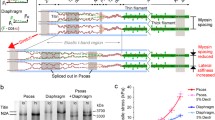Summary
Tension responses induced by ramp stretches (amplitude of 1–2% fibre length and speeds of 0.01–15 L o s-1) were examined in resting intact muscle fibre bundles isolated from the extensor digitorum longus (a fast muscle) of the rat; sarcomere length of a 2 mm region was monitored near the tension transducer end by means of a He-Ne laser diffractometer. The experiments were done at 10°C. During a ramp stretch, the tension rose rapidly (P1) and then slowly (P2) to reach a peak; after completion of the ramp, the tension decayed in a complex manner to a steady level (P3) at approximately constant sarcomere length. At stretch velocities higher than ∼1–2 L o s-1, P1 tension increased in direct proportion to stretch velocity, indicating that it is due to viscous resistance; in a half sarcomere, the viscous resistance to filament sliding may be about 5 × 108 N s m-3. The steady tension level after the ramp (P3 tension) was independent of stretch velocity indicating that it represents an elastic tension. The amplitude of the slow tension rise (P2 tension corrected for P3) increased with stretch velocity up to a plateau (as in a visco-elastic component); the calculated relaxation time was 5–13 ms. Amplitudes of all three components were larger at longer sarcomere length (range 2.4–3 μm). The presence of 5–10 mm BDM which abolished the twitch and markedly depressed the tetanic responses, produced little or no change in the tension components. Our results show that none of the tension components to stretch in relaxed mammalian muscle fibres is due to active, cycling cross-bridges; the possibility that the resting sarcomeric visco-elasticity (net P2) resides in the connectin (=titin) containing gap filament is discussed.
Similar content being viewed by others
References
Bagni M. A., Cecchi G., Colomo F. & Garzella P. (1992). Are weakly binding bridges present in intact muscle fibers? Biophys. J. 63, 1412–15.
Bagni M.A., Cecchi G., Colomo F. & Garzella P. (1995). Absence of mechanical evidence for attached weakly binding cross-bridges in frog relaxed muscle fibres. J. Physiol. 482, 391–400.
Brenner B., Schoenberg M., Chalovich J. M., Greene L. E. & Eisenberg E. (1982). Evidence for crossbridge attachment in relaxed muscle at low ionic strength. Proc. Natl Acad. Sci. USA 79, 7288–391.
Erickson H. P. (1994). Reversible unfolding of fibronectin type III and immunoglobulin domains provides the structural basis for stretch and elasticity of titin and fibronectin. Proc. Natl Acad. Sci. USA 91, 10114–18.
Ford L. E., Huxley A. F. & Simmons R. M. (1977). Tension responses to sudden length change in stimulated muscle fibres near slack length. J. Physiol. 269, 441–515.
Fryer M. W., Neering I. R. & Stephenson D. G. (1988). Effects of 2,3-Butanedione Monoxime on the contractile activation properties of fast-and slow-twitch rat muscle fibres. J. Physiol. 407, 53–75.
Goldman Y. E. & Simmons R. M. (1984). Control of sarcomere length in skinned muscle fibres of Rana temporaria during mechanical transients. J. Physiol. 350, 497–518.
Goldman Y. E. & Simmons R. M. (1986). The stiffness of frog skinned muscle fibres at altered lateral filament spacing. J. Physiol. 378, 175–94.
Hill A. V. (1952). The thermodynamics of elasticity in resting striated muscle. Proc. R. Soc. (Lond.) B 139, 464–97.
Hill D. K. (1968). Tension due to interaction between the sliding filaments in resting striated muscle. The effect of stimulation. J. Physiol. 199, 637–84.
Hufschmidt A. & Schwaller I. (1987). Short-range elasticity and resting tension of relaxed human lower leg muscles. J. Physiol. 391, 451–65.
Lakie M. & Robson L. G. (1988a). Thixotrophy: stiffness recovery rate in relaxed frog muscle. Quart. J. Exp. Physiol. 73, 237–9.
Lakie M. & Robson L. G. (1988b). Thixotropic changes in human muscle stiffness and the effects of fatigue. Quart. J. Exp. Physiol. 73, 237–9.
Lakie M., Walsh E. G. & Wright G. W. (1984). Resonance at the wrist demonstrated by the use of a torque motor: an instrumental analysis of muscle tone in man. J. Physiol. 353, 265–83.
Lannergren J. (1971). The effect of low level activation on the mechanical properties of isolated frog muscle fibres. J. Gen. Physiol. 58, 145–62.
McKillop D. F. A., Fortune N. S., Ranatunga K. W. & Geeves M. A. (1994). The influence of 2,3-batanedione 2-monoxime (BDM) on the interaction between actin and myosin in solution and in skinned fibres. J. Muscle Res. Cell Motil. 15, 309–18.
MUTUNGI, G. & RANATUNGA, K. W. (1994a). Tension reponses to stretch in resting intact mammalian (rat) muscle fibres at different temperatures. J. Physiol. 476P, 14P.
MUTUNGi, G. & RANATUNGA, K. W. (1994b). Stretch-induced tension responses in resting intact rat muscle fibres at different temperatures. J. Physiol. 479P, 157P.
Mutungi G. & Ranatunga K. W. (1995). The effects of velocity on the rising phase of ramp stretch-induced tension responses in resting intact rat muscle fibres at 10 and 35°C. J. Muscle Res. Cell Motil. 16, 154.
Politou A. S., Gautel M., Pfuhl M., Labeit S. & Pastore A. (1994). Immunoglobin-type domains of titin: same fold, different stability? Biochem. 33, 4730–7.
Ranatunga K. W. (1984). The force-velocity relation of rat fast-and slow-twitch muscles examined at different temperatures. J. Physiol. 351, 517–29.
Ranatunga K. W. (1994). Thermal stress and Ca-independent contactile activation in mammalian skeletal muscle fibers at high temperatures. Biophys. J. 66, 1531–41.
Schoenberg M. (1988). Characterization of the myosin adenosine triphosphate (M ATP) crossbridge in rabbit and frog skeletal muscle fibers. Biophys. J. 54, 135–48.
Author information
Authors and Affiliations
Rights and permissions
About this article
Cite this article
Mutungi, G., Ranatunga, K.W. The visco-elasticity of resting intact mammalian (rat) fast muscle fibres. J Muscle Res Cell Motil 17, 357–364 (1996). https://doi.org/10.1007/BF00240933
Received:
Accepted:
Issue Date:
DOI: https://doi.org/10.1007/BF00240933




